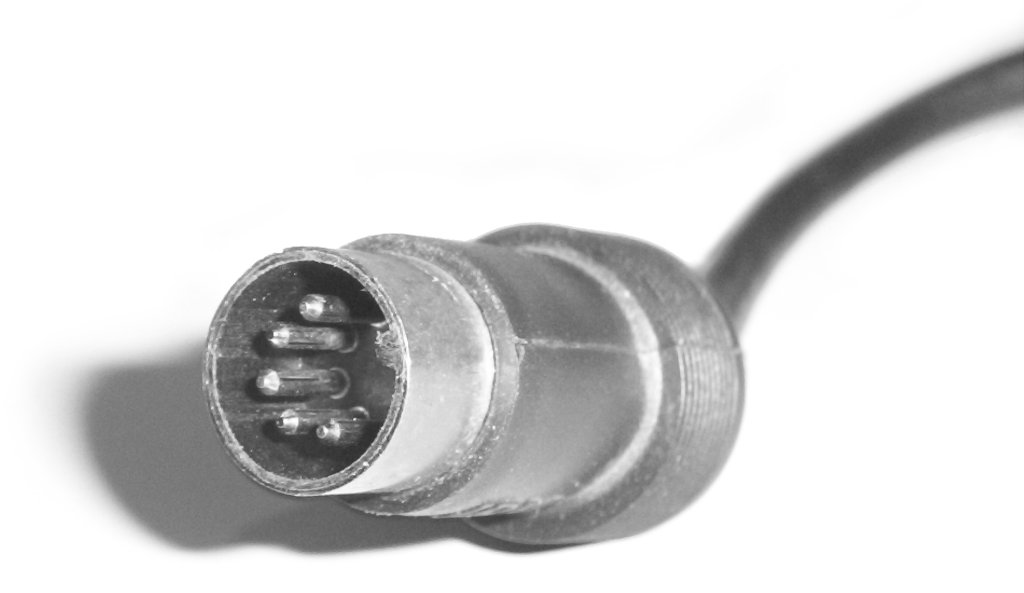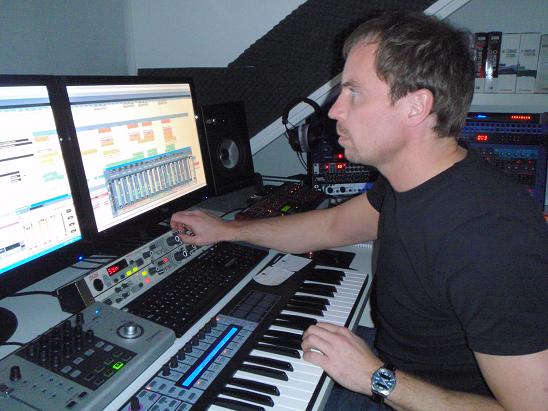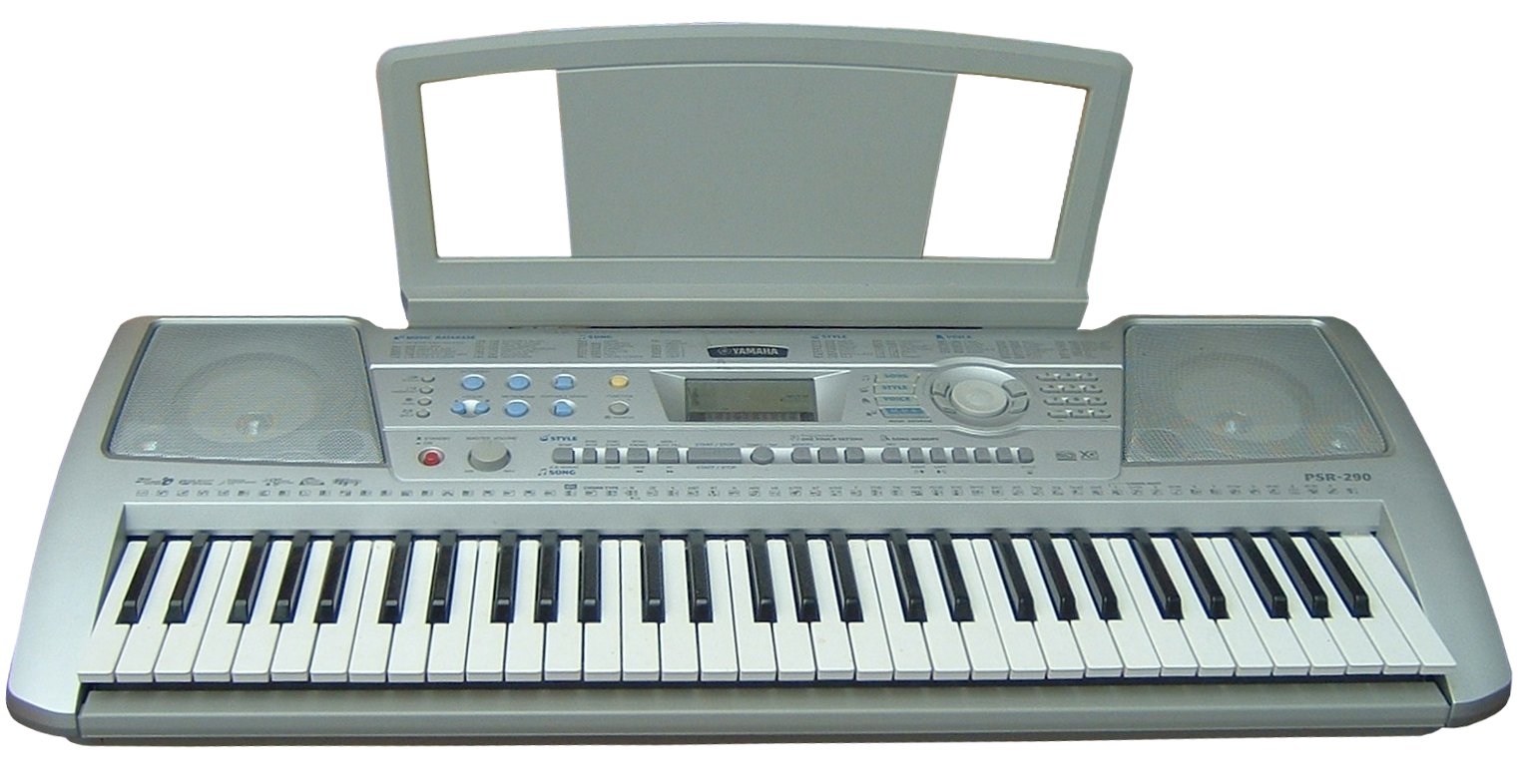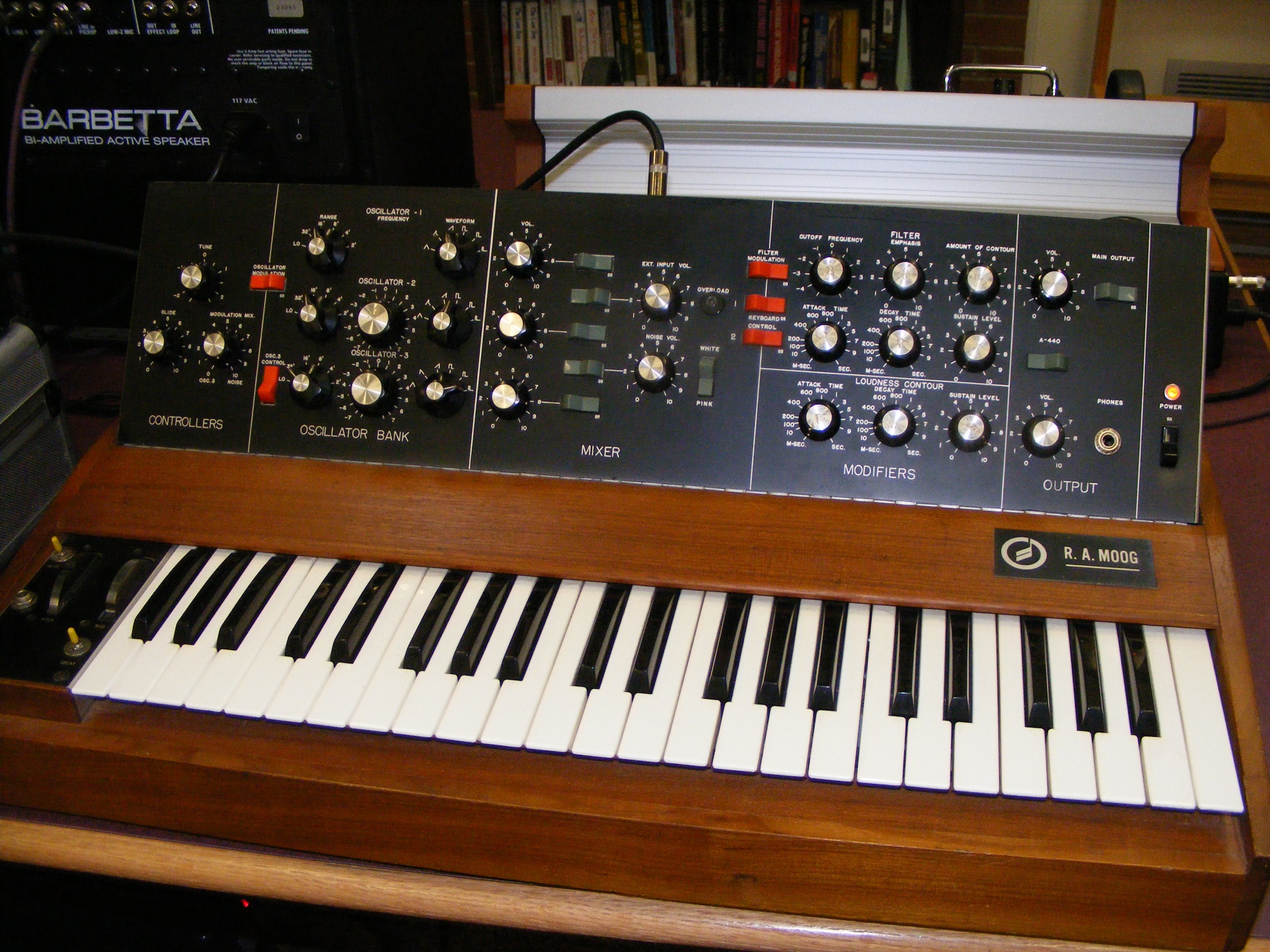|
Midi
Musical Instrument Digital Interface (; MIDI) is an American-Japanese technical standard that describes a communication protocol, digital interface, and electrical connectors that connect a wide variety of electronic musical instruments, computers, and related audio devices for playing, editing, and recording music. A single MIDI cable can carry up to sixteen channels of MIDI data, each of which can be routed to a separate device. Each interaction with a key, button, knob or slider is converted into a MIDI event, which specifies musical instructions, such as a note's pitch, timing and velocity. One common MIDI application is to play a MIDI keyboard or other controller and use it to trigger a digital sound module (which contains synthesized musical sounds) to generate sounds, which the audience hears produced by a keyboard amplifier. MIDI data can be transferred via MIDI or USB cable, or recorded to a sequencer or digital audio workstation to be edited or played back. ... [...More Info...] [...Related Items...] OR: [Wikipedia] [Google] [Baidu] |
Music Sequencer
A music sequencer (or audio sequencer or simply sequencer) is a device or application software that can record, edit, or play back music, by handling Musical note, note and performance information in several forms, typically CV/Gate, MIDI, or Open Sound Control, and possibly audio signal, audio and automation data for digital audio workstations (DAWs) and Audio plugin, plug-ins. Overview Modern sequencers The advent of Musical Instrument Digital Interface (MIDI) in the 1980s gave programmers the opportunity to design software that could more easily record and play back sequences of notes played or programmed by a musician. As the technology matured, sequencers gained more features, such as the ability to record multitrack audio. Sequencers used for audio recording are called digital audio workstations (DAWs). Many modern sequencers can be used to control Software synthesizer, virtual instruments implemented as software Audio plug-in, plug-ins. This allows musicians to repl ... [...More Info...] [...Related Items...] OR: [Wikipedia] [Google] [Baidu] |
DIN Sync
DIN sync, also called Sync24, is a synchronization interface for electronic musical instruments. It was introduced in 1980 by Roland Corporation and has been superseded by MIDI. Definition and history DIN sync was introduced in 1980 by Roland Corporation with the release of the TR-808 drum machine. The intended use was the synchronization of music sequencers, drum machines, arpeggiators and similar devices. It was superseded by MIDI in the mid-to-late 1980s. DIN sync consists of two signals, clock (tempo) and run/stop. Both signals are TTL compatible, meaning the low state is 0 V and the high state is about +5 V. The clock signal is a low-frequency pulse wave suggesting the tempo. Instead of measuring the waveform's frequency, the machine receiving the signal merely has to count the number of pulses to work out when to increment its position in the music. Roland equipment uses 24 pulses per quarter note, known as Sync24. Therefore, a Roland-compatible dev ... [...More Info...] [...Related Items...] OR: [Wikipedia] [Google] [Baidu] |
Music Technology (electronic And Digital)
Digital music technology encompasses the use of digital instruments to produce, perform or sound recording, record music. These instruments vary, including computers, electronic effects units, software, and digital audio equipment. Digital music technology is used in performance, playback, recording, musical composition, composition, Audio mixing (recorded music), mixing, Music informatics, analysis and Digital audio editor, editing of music, by professions in all parts of the music industry. History In the late 19th century, Thaddeus Cahill introduced the Telharmonium, which is commonly considered the first electromechanical musical instrument. In the early 20th century, Leon Theremin created the Theremin, an early electronic instrument played without physical contact, creating a new form of sound creation. In the mid-20th century, Sampling (music), sampling emerged, with artists like Pierre Schaeffer and Karlheinz Stockhausen manipulating recorded sounds on tape to create e ... [...More Info...] [...Related Items...] OR: [Wikipedia] [Google] [Baidu] |
Electronic Keyboard
An electronic keyboard, portable keyboard, or digital keyboard is an electronic musical instrument based on keyboard instruments. Electronic keyboards include synthesizers, digital pianos, stage pianos, electronic organs and digital audio workstations. In technical terms, an electronic keyboard is a rompler-based synthesizer with a low-wattage power amplifier and small loudspeakers. Electronic keyboards offer a diverse selection of instrument sounds (piano, organ, violin, etc.) along with synthesizer tones. Designed primarily for beginners and home users, they generally feature unweighted keys. While budget models lack velocity sensitivity, mid-range options and above often include it. These keyboards have limited sound editing options, focusing on preset sounds. Casio and Yamaha Corporation, Yamaha are major manufacturers in this market, known for popularizing the concept since the 1980s. Terminology An electronic keyboard may also be called a digital keyboard, or home ... [...More Info...] [...Related Items...] OR: [Wikipedia] [Google] [Baidu] |
CV/gate
CV/gate (an abbreviation of ''control voltage/gate'') is an analog method of controlling synthesizers, drum machines, and similar equipment with external sequencers. The control voltage typically controls pitch and the gate signal controls note on-off. This method was widely used in the epoch of analog modular synthesizers and CV/Gate music sequencers, since the introduction of the Roland MC-8 Microcomposer in 1977 through to the 1980s, when it was eventually superseded by the MIDI protocol (introduced in 1983), which is more feature-rich, easier to configure reliably, and more readily supports polyphony. The advent of digital synthesizers also made it possible to store and retrieve voice "patches" – eliminating patch cables and (for the most part) control voltages. However, numerous companies – including Doepfer, who designed a modular system for Kraftwerk in 1992, Buchla, MOTM, Analogue Systems, and others continue to manufacture modular synthesizers that are incr ... [...More Info...] [...Related Items...] OR: [Wikipedia] [Google] [Baidu] |
MIDI Manufacturers Association
The MIDI Manufacturers Association (MMA) is a non-profit trade organization where companies work together to create MIDI standards comparison, MIDI standards that assure compatibility among MIDI products. The MMA is a U.S. organization established in 1985 by the original developers of the MIDI 1.0 Specification in 1983. Since 1985 the MMA has produced 11 new specifications and adopted 38 sets of enhancements to MIDI. See also *Association of Musical Electronics Industry *Show control **Comparison of MIDI standards **Standard MIDI File **DLS format **XMF References External links MIDI Manufacturers Association at NAMM Oral History Program, NAMM Oral History Collection, January 27, 2013. MIDI Organizations established in 1985 1985 establishments in the United States {{business-org-stub ... [...More Info...] [...Related Items...] OR: [Wikipedia] [Google] [Baidu] |
Sound Module
A sound module is an electronic musical instrument without a human-playable interface such as a piano-style musical keyboard. Sound modules have to be operated using an externally connected device, which is often a MIDI controller, of which the most common type is the musical keyboard. Another common way of controlling a sound module is through a sequencer, which is computer hardware or software designed to record and playback control information for sound-generating hardware. Connections between sound modules, controllers, and sequencers are generally made with MIDI (Musical Instrument Digital Interface), which is a standardized interface designed for this purpose. Sound modules are often rack-mountable, but are also produced in table-top form factor, particularly when the intended user is a DJ or record producer. The height of a sound module is often described in rack units. Small sound modules are mostly 1U in height, the larger models a multiplication e.g. 2U or 3U. De ... [...More Info...] [...Related Items...] OR: [Wikipedia] [Google] [Baidu] |
Digital Audio Workstation
A digital audio workstation (DAW ) is an electronic device or application software used for Sound recording and reproduction, recording, editing and producing audio files. DAWs come in a wide variety of configurations from a single software program on a laptop, to an integrated stand-alone unit, all the way to a highly complex configuration of numerous components controlled by a central computer. Regardless of configuration, modern DAWs have a central interface that allows the user to alter and mix multiple recordings and tracks into a final produced piece. DAWs are used for producing and recording music, songs, speech, Radio broadcasting, radio, television, soundtracks, podcasts, sound effects and nearly every other kind of complex recorded audio. History Early attempts at digital audio workstations in the 1970s and 1980s faced limitations such as the high price of storage, and the vastly slower processing and disk speeds of the time. In 1978, Soundstream, who had made one ... [...More Info...] [...Related Items...] OR: [Wikipedia] [Google] [Baidu] |
Electronic Musical Instrument
An electronic musical instrument or electrophone is a musical instrument that produces sound using electronics, electronic circuitry. Such an instrument sounds by outputting an electrical, electronic or digital audio signal that ultimately is plugged into a power amplifier which drives a loudspeaker, creating the sound heard by the performer and listener. An electronic instrument might include a user interface for controlling its sound, often by adjusting the pitch (music), pitch, frequency, or duration of each Musical note, note. A common user interface is the musical keyboard, which functions similarly to the keyboard on an acoustic piano where the keys are each linked mechanically to swinging string hammers - whereas with an electronic keyboard, the keyboard interface is linked to a synth module, computer or other electronic or digital sound generator, which then creates a sound. However, it is increasingly common to separate user interface and sound-generating functions int ... [...More Info...] [...Related Items...] OR: [Wikipedia] [Google] [Baidu] |
Sampler (musical Instrument)
A sampler is an electronic musical instrument that records and plays back samples (portions of sound recordings). Samples may comprise elements such as rhythm, melody, speech, sound effects or longer portions of music. The mid-20th century saw the introduction of keyboard instruments that played sounds recorded on tape, such as the Mellotron. As technology improved, cheaper standalone samplers with more memory emerged, such as the E-mu Emulator, Akai S950 and Akai MPC. Samples may be loaded or recorded by the user or by a manufacturer. The samples can be played back by means of the sampler program itself, a MIDI keyboard, sequencer or another triggering device (e.g., electronic drums). Because these samples are usually stored in digital memory, the information can be quickly accessed. A single sample may be pitch-shifted to different pitches to produce musical scales and chords. Often samplers offer filters, effects units, modulation via low frequency oscillation ... [...More Info...] [...Related Items...] OR: [Wikipedia] [Google] [Baidu] |
Synth Rack @ Choking Sun Studio
A synthesizer (also synthesiser or synth) is an electronic musical instrument that generates audio signals. Synthesizers typically create sounds by generating waveforms through methods including subtractive synthesis, additive synthesis and frequency modulation synthesis. These sounds may be altered by components such as filters, which cut or boost frequencies; envelopes, which control articulation, or how notes begin and end; and low-frequency oscillators, which modulate parameters such as pitch, volume, or filter characteristics affecting timbre. Synthesizers are typically played with keyboards or controlled by sequencers, software or other instruments, and may be synchronized to other equipment via MIDI. Synthesizer-like instruments emerged in the United States in the mid-20th century with instruments such as the RCA Mark II, which was controlled with punch cards and used hundreds of vacuum tubes. The Moog synthesizer, developed by Robert Moog and first sold in 19 ... [...More Info...] [...Related Items...] OR: [Wikipedia] [Google] [Baidu] |








